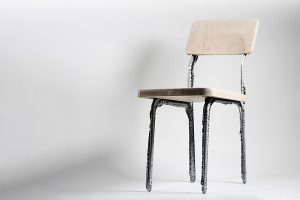MIT’s new 3D printing tech can make furniture in minutes

MIT’s new 3D printing tech can make furniture in minutes
It sounds like something straight out of a Star Trek episode, but researchers at the Massachusetts Institute of Technology (MIT) have demonstrated a new method of 3D printing that can produce furniture in mere minutes.
MIT scientists revealed on Thursday (Jan.25) an exciting new manufacturing process that rapidly prints large metal parts using streams of molten aluminum. The new method, called liquid metal printing (LMP), deposits the molten metal into a bed of glass beads, where it quickly cools and solidifies.
How does it all work?
In the LMP process, aluminum is heated to 700°C (1292°F) in an electric furnace until molten. The liquid metal is then dispensed from a nozzle as it travels along a programmed path into a print bed filled with tiny glass beads. The beads act as a support material, allowing the aluminum to solidify rapidly after exiting the print nozzle.
Compared to other metal 3D printing techniques, LMP is extremely fast. Parts can be printed in just seconds or minutes, according to the researchers.
This speed comes at the sacrifice of resolution though. While suitable for making large components like architectural features, furniture frames, or prototypes, LMP cannot match the fine detail of some slower additive manufacturing methods.
The research team, led by MIT professor Skylar Tibbits, successfully printed aluminum parts like table legs and chair frames using their LMP technique. They combined these rapidly printed but low-resolution components with conventionally manufactured parts to assemble full pieces of furniture.
Researcher Zain Karsan explains: “Our process rate is really high, but it is also very difficult to control. It is more or less like opening a faucet. You have a big volume of material to melt, which takes some time, but once you get that to melt, it is just like opening a tap. That enables us to print these geometries very quickly.”
Tibbits sees the rapid, low-cost nature of LMP as having huge advantages for manufacturing scale structures using recycled metals. “It has downsides too. But most of our built world…doesn’t need extremely high resolution. Speed and scale, and also repeatability and energy consumption, are all important metrics,” he says.
The researchers do acknowledge that LMP faces some ongoing technical obstacles related to heating consistency and material flow control. However, their goal is to refine the LMP machine and process to enable reliable printing that could someday convert scrap aluminum into end-use products or parts. This would be a game-changer for sustainable metal manufacturing, Tibbits notes.
More on 3D Printing
- How to 3D print amazing models for your games room on a Bambu Lab A1
- How to 3D print huge models for cosplay and game rooms with the Neptune 4 Max
- 3D Printing: 10 Ways it Could Transform the Construction Industry
Featured image: MIT


